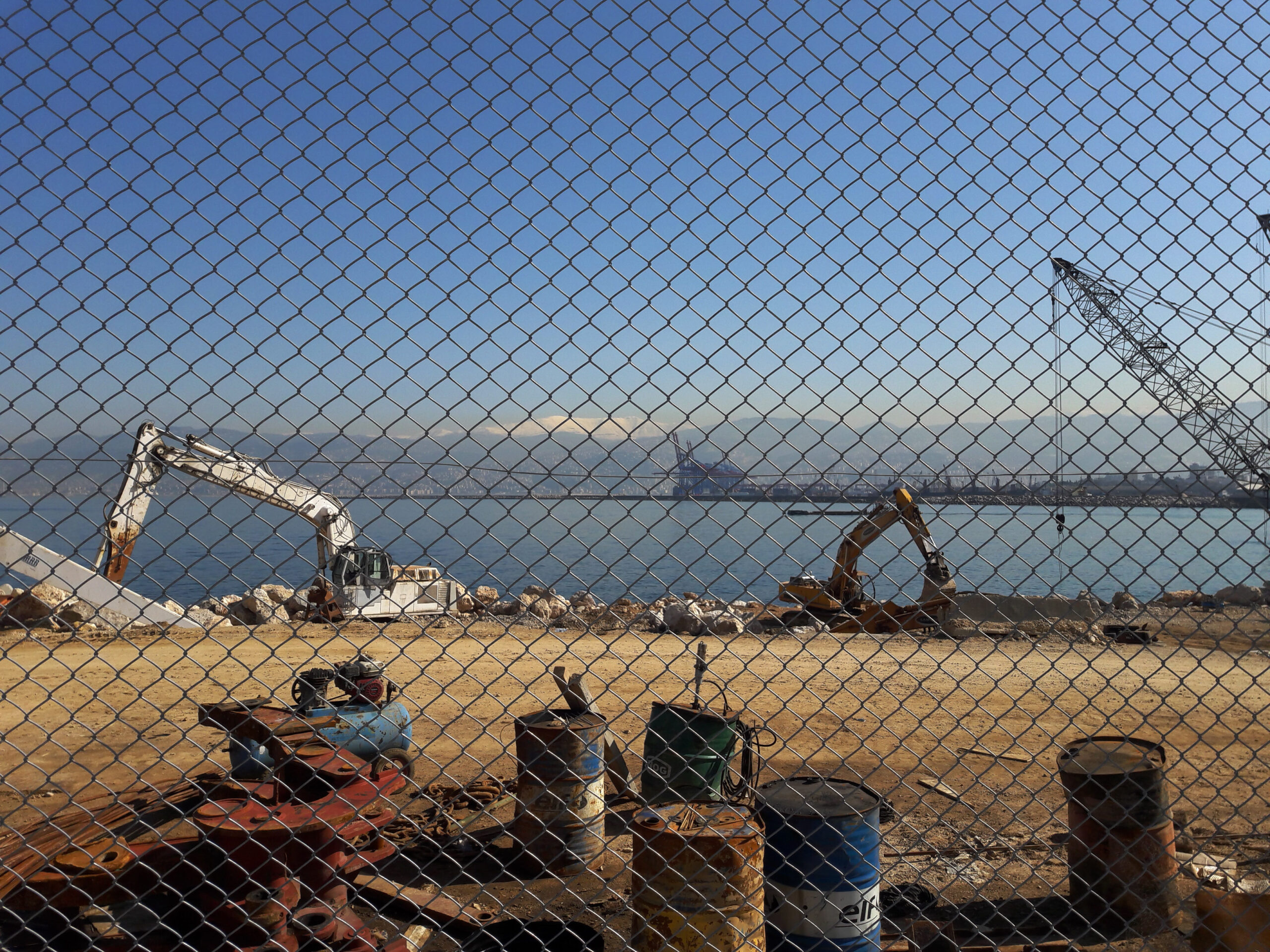“The true image of the past flits by. The past can be seized only as an image that flashes up at the moment of its recognizability, and is never seen again.”
- Walter Benjamin
At night, you can usually find bats doing playful death dives across the Cairo skyline. Bats usually scare me, but in these moments of stillness they are my comrades. I imagine that they welcome me into their nocturnal journeys. That they can sense I too prefer to fly at night, fighting the coming of daylight. In my anthropomorphic imaginations, I feel that they understand me and I am comforted by the understanding I project onto them.
But in the morning when they enter their roosts, I am left alone to witness the daily labors of erasure in the city. I awaken to sights and sounds of the frantic urgency with which men break and build the future of Cairo. From my apartment balcony, silhouettes of cranes crowd the view and dust emanates from the con(de)struction of homes, livelihoods, and memories of this historic landscape. The familiar tilted portrait of a man who came to power by coup rises from these projects to assure the people that this is for them, with or without their consent.
The razing of the city is not indiscriminate nor aimless. The Egyptian state is laying brick and concrete over ideologically dangerous geographies. They are reconfiguring spaces the regime so desperately wants you to forget. It's why when widening a road, they destroyed a cemetery. To celebrate heritage, they installed an obelisk over the square where the martyrs died. To ease traffic, they race to build a new capital far away from Tahrir, Mohamed Mahmood, and Maspero. For a 10% down payment, you too can afford manufactured desert luxury away from the inconvenient truths of the past.
Every week, I sit in a circle with a group of interdisciplinary students in this city which is theirs and we discuss how to slow this assault on history. I teach a class entitled “The Archives of Memory and Forgetting” uniquely tailored for this purpose. We talk about how to counter the destruction of the bulldozers with our words. We ask about archives and power. We argue about whose memories matter. We agree that forgetting can be a trauma response, not always a consequence of nefarious violence. Their reflections are not simply testaments, but they pull out wisdom that only comes from living through impossible times. These class sessions are the highlight of my week.
The inspiration for this class started when I read Milan Kundera’s first short story in his Book of Laughter and Forgetting about a man pursued by an authoritarian regime because he exposes its whitewashing of history. The man knows he is being watched and followed. He knows his time is running out. He tries to seek out a former lover and the reader is led to believe that perhaps in his final act of freedom, he wants to tell her he loves her. That he has always loved her. We learn in the course of time what he really wants is to know if she kept his love letters and if she can destroy them. To destroy the evidence that he loved, what everyone perceived to be, an ugly woman.
In a twist of irony, the story is not so much about the man’s heroic efforts to expose the regime but to cover up evidence that he loved a woman who only he saw as beautiful. He becomes the primary agent in the erasure of his own history. And this is what I want to talk to my students about. I want to ask them: How do advocates of historical memory become agents of historical forgetting?
*
Erasure, as Rosie Bsheer, a historian of the Middle East, reminds us, is just as much a part of history as the history it seeks to destroy. And history is what I do for a living. I spend my days chasing traces of people no longer with us. I dig through dust-filled shelves and finger through decaying paper to write them into narratives that do not yet exist as knowledge about the past. We are trained to be meticulous. To pursue every lead. Leave no stone unturned. Footnotes and google docs and spreadsheets until the archive fever breaks. Above all, to cite our sources. Sources are how we make claims to the past–the raison d'être of our profession. And so, as a historian, erasure feels antithetical to the modus operandi of my life’s work.
Which is why, at times, I find myself in contradiction between my research methods and my own experiences of the city and its people.
Many years ago in Cairo I fell in love with a documentary photographer. Actually, I first fell in love with his photos before we even met. When I was conducting interviews for my research project, all my interlocutors recommended his work. I googled him. I read reviews of his shows. His use of light, the way he captured emotion. His photo series on remembering those who remembered the lost. He had amassed his own visual archive of the revolution and its survivors.
I somehow managed to arrange a meeting to interview him—I was nervous and I remember wearing heels just so I could feign confidence as my hands shook in anticipation. When we met, I could tell he was shy but with an overt sense of humor that was at once sexy and reserved. His eyes played with his eyebrows before a joke or a laugh. In between his sips of coffee and rolling cigarettes, I would ask questions and his answers would come swiftly. For all his personal reservations, he was forthright about his work. His brave and bold photos proved that.
I admired him from afar until, taken completely by surprise, I was able to do it up close. We shared slow, aching moments across Cairo’s antiquated elevators, dim lit rooms, and haunted apartments. Hungry eyes to match hungry hands wildly surveying bodyscapes as if it was going to disappear the next second. Coming up for air only to realize the night had turned into morning. Each time we were together, he would remind me of the time before—he had an impeccable memory for the details of our intimacies. Perhaps due to the nature of his work, he was also aware of the camera and always asked for photos I took of him. I was only happy to oblige, I would have done anything he asked.
It was perhaps because of this habit that I never understood why he wouldn’t share the pictures he always took of our times together. It was a professional’s proof of what we had. Was it because he could only be with me in secret? Or rather, only at night to the knowledge of no one—behind closed doors, during stolen moments? On occasion, he would let me peek at his camera to see assemblages of shadows and light. They captured a feeling more than the moment, which is what I loved about his work in the first place. When I asked to have these photos, he said he would send them, but years later I am still waiting.
Sometimes I think about the Kundera story and get the impulse to go to him and insist on accessing this unseen archive. I contrast my own research process of carefully cited documentation with my inability to cite the evidence that I loved a beautiful man who inspired me to love this city which is now changing at a pace I can no longer keep up with. This city is changing just as he is, just as I am. Even in the anxiety about losing evidence from the past, I do not have the courage to demand proof of my memories. Maybe because it's too painful. Maybe because it is better to forget. Maybe it's just easier to participate in the erasure of my past than contend with the futures that didn’t come.
*
I am back with my students, sitting on the floor of the classroom, and we share a series of somber moments. This is not an easy class to teach and certainly harder to take—the topics can be painful and emotional—and we are not neutral observers. Even though we talk about mass graves in Spain and the British setting sources ablaze in the twilight of their empire, we think about the sit-in dispersals of August 2013 and the denial over what happened here since.
Although I lived in Cairo during the revolution and most of my adult life has been spent studying, researching, and living in this country, I am not Egyptian. I did not live my students’ lives connected to Cairo in only the ways they could. I did not experience their losses or share in their grief. I did not see their city mangled into a ruling elite’s vision of the future. In a rare instance of vulnerability, halfway through the course, some of the students and I shared emotional embraces over the neighborhoods or places we no longer visit because of their association with painful memories. I am touched by the honor of sharing space with these brilliant intellectuals who deserve a world denied to them.
In truth, every week we are in the trenches of historical speculation. But this is my favorite part—when we imagine contingencies of the past that could have been the reality of our present. We sit in speculation about the past and imagine, even if cynically, possibilities of the future. Proof that we have not yet been defeated.
The part of me that wants to see the forbidden photographs is the girl who desires to see and feel Cairo in her most intimate moments with the city. When there were more possibilities in the city, the streets filled with my friends and lovers. Many of them have left, and now the bulldozers are finishing the work of erasure. That girl clings to a vision of time that is no longer possible. As Walter Benjamin noted, it is an image of recognition that only exists in that moment and is rendered unfamiliar in the next.
Another part of me makes peace with the idea of never seeing these pictures. I think about my students and other brave people like them who are building and remembering despite the unequal forces of power against them. I think of their work as I take an Uber down the mamsha construction zone along the corniche, the eyesore Maspero triangle development, and the Tahrir Square obelisk that no one can see up close. I also think more about the lives of Egypt’s bats.
At the onset of the pandemic, reports of bat infestations in the governorates of Qalubiya, Minya and Sohag worried Egyptian villagers about the spread of coronavirus. It turns out the bats had made their home among abandoned and historic buildings up along the Nile Valley. Experts say they specifically seek out these structures and I wonder if maybe it's because the bats find comfort in the custodianship of that which has not yet been destroyed. I wonder if the bats, like us, are witnesses of the archives of memory during a time of erasure.

Amy Fallas
Amy Fallas is a Salvadoran-Costa Rican writer, editor, and historian based in Cairo. She received her MA in History from Yale University and is currently a PhD Candidate in Middle East History at UC Santa Barbara. She is an assistant editor of the Arab Studies Journal and her writing appears in the Washington Post, Jadaliyya, Tahrir Institute for Middle East Policy, Contingent Magazine, The Revealer, and more.




